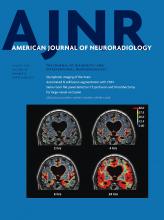Abstract
BACKGROUND AND PURPOSE: Synthetic MR imaging enables the acquisition of phase-sensitive inversion recovery images. The aim of this study was to compare the image quality of synthetic phase-sensitive inversion recovery with that of other sequences in infants.
MATERIALS AND METHODS: Brain MR imaging with 3D T1-weighted fast-spoiled gradient recalled, synthetic T1WI, and synthetic phase-sensitive inversion recovery of 91 infants was compared. Contrast between unmyelinated WM and myelinated WM and between unmyelinated WM and cortical GM was calculated. Qualitative evaluation of image quality and myelination degree was performed. In infants with punctate white matter injuries, the number of lesions was compared.
RESULTS: The contrast between unmyelinated WM and myelinated WM was higher in synthetic phase-sensitive inversion recovery compared with fast-spoiled gradient recalled or synthetic T1WI (P < .001). Compared with synthetic T1WI, synthetic phase-sensitive inversion recovery showed higher gray-white matter differentiation (P < .001) and myelination degree in the cerebellar peduncle (P < .001). The number of detected punctate white matter injuries decreased with synthetic phase-sensitive inversion recovery compared with fast-spoiled gradient recalled sequences (1.2 ± 3.2 versus 3.4 ± 3.6, P = .001).
CONCLUSIONS: Synthetic phase-sensitive inversion recovery has the potential to improve tissue contrast and image quality in the brain MR imaging of infants. However, we have to be aware that synthetic phase-sensitive inversion recovery has limited value when assessing punctate white matter injuries compared with 3D fast-spoiled gradient recalled imaging.
ABBREVIATIONS:
- CP
- cerebellar peduncle
- FSPGR
- fast-spoiled gradient recalled
- GM-WM
- gray-white matter differentiation
- mWM
- myelinated white matter
- PSIR
- phase-sensitive inversion recovery
- uWM
- unmyelinated white matter
- © 2019 by American Journal of Neuroradiology
Indicates open access to non-subscribers at www.ajnr.org







